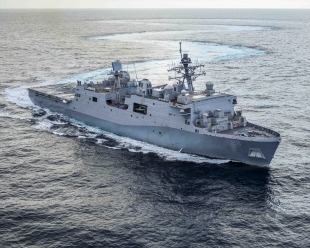Amphibious transport dock USS Fort Lauderdale (LPD-28)
Classification
Basic information
Ship measurements
Machine
- Four Colt-Pielstick diesel engines, two shafts, 40,000 hp (29,828 kW)
Personnel
Combat assets
- 2 * LCACs (air cushion)
- or 1 * LCU (conventional)
- AN / SPS-48E
- AN / SPQ-9 B
- AN / SPS-73
- AN / SLQ-25A Nixie
- AN / SLQ-32 A (V) 2
- SRBOC
- MK 53 / Nulka
- 2 * 30 mm Bushmaster II cannon, for surface threat defense
- 2 * Rolling Airframe Missile launchers for air defense
- 4 * Boeing Vertol CH-46 Sea Knight helicopters or 2 * Bell Boeing V-22 Osprey
USS Fort Lauderdale (LPD-28) will be the twelfth San Antonio-class amphibious transport dock ship of the United States Navy, the ship is the first ship of the United States Navy to be named for Fort Lauderdale, Florida. Fort Lauderdale is under construction at Pascagoula, Mississippi by Ingalls Shipbuilding.
Fort Lauderdale will feature design improvements developed in connection with the Navy's development of a next-generation dock landing ship, known as the LX(R)-class amphibious warfare ship. The LX(R) is intended to replace current Whidbey Island-class and Harpers Ferry-class dock landing ships. In 2014, the Navy commenced design of LX(R) based on a modified San Antonio-class design. Because this design work is in progress, the Navy has created design innovations and cost-reduction strategies around the San Antonio-class design, and the Navy believes that it can apply these innovations and strategies to Fort Lauderdale, allowing her to be built at reduced cost. The main design features intended to reduce the cost of Fort Lauderdale compared to the San Antonio-class on which she is based are simplified bow works, replacement of the forward and aft composite masts with steel masts, removal of structures from the boat valley, and a stern gate which is open at the top. This will make Fort Lauderdale a «transitional ship» between the current San Antonio-class design and future LX(R) vessels.
Fort Lauderdale will incorporate a high temperature superconductor-based mine protection degaussing system built by American Superconductor to reduce the magnetic signature of the ship.
On 7 March 2016, a local news outlet reported that the Navy intended to name a littoral combat ship after Fort Lauderdale, but two days later that was determined to be an error as a result of miscommunication with the Navy, and that a new amphibious transport dock would actually bear the name.
The contract to build Fort Lauderdale was awarded to Huntington Ingalls Industries's Ingalls Shipyard on 19 December 2016. Fort Lauderdale's keel was laid down on 13 October 2017, at Ingalls Shipyard in Pascagoula, Mississippi. She was launched on 28 March 2020.
- Comments
 en
en ru
ru uk
uk




 United States Navy
United States Navy Ingalls Shipbuilding
Ingalls Shipbuilding